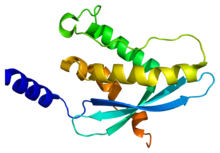- NCF4
-
Factor citosólico 4 de neutrófilos 
Estructura tridimensional de la proteína NCF4.HUGO 7662 Símbolo NCF4 Símbolos alt. MGC3810; NCF; P40PHOX; SH3PXD4 Datos genéticos Locus Cr. 22 q12.3 Bases de datos Entrez 4689 OMIM 601488 PDB 1h6h RefSeq NP_000622 UniProt Q15080 El factor citosólico 4 de neutrófilos (NCF4) es una proteína codificada en humanos por el gen NCF4.[1] [2]
La proteína codificada por este gen es un regulador citosólico que forma parte de la NADPH-oxidasa fagocítica productora de superóxido, un sistema enzimático multicomponente muy importante en la defensa del hospedador que sufre una infección. Esta proteína se expresa preferentemente en células de linaje mieloide. Interacciona principalmente con el factor citosólico 2 de neutrófilos (NCF2/p67-phox) para formar un complejo con el factor citosólico 1 de neutrófilos (NCF1/p47-phox), que interaccionará finalmente con la proteína G pequeña RAC1 y se traslocará a la membrana tras la estimulación celular. Este complejo activará entonces al flavocitocromo b, la subunidad catalítica integrada en membrana del sistema enzimático. El dominio PX de esta proteína puede unir productos fosfolipídicos de la PI3 quinasa, lo que sugiere un papel como mediador en procesos de señalización celular mediados por PI3 quinasa. La fosforilación de esta proteína parece regular negativamente la actividad enzimática. Se han descrito diversas variantes transcripcionales del gen, que codifican diferentes isoformas de la proteína.[2]
Interacciones
La proteína NCF4 ha demostrado ser capaz de interaccionar con:
Referencias
- ↑ Zhan S, Vazquez N, Zhan S, Wientjes FB, Budarf ML, Schrock E, Ried T, Green ED, Chanock SJ (Nov 1996). «Genomic structure, chromosomal localization, start of transcription, and tissue expression of the human p40-phox, a new component of the nicotinamide adenine dinucleotide phosphate-oxidase complex». Blood 88 (7): pp. 2714–21. PMID 8839867.
- ↑ a b «Entrez Gene: NCF4 neutrophil cytosolic factor 4, 40kDa».
- ↑ Grandvaux, N; Grizot S, Vignais P V, Dagher M C (Feb. 1999). «The Ku70 autoantigen interacts with p40phox in B lymphocytes». J. Cell. Sci. (ENGLAND) 112 ( Pt 4): pp. 503–13. ISSN 0021-9533. PMID 9914162.
- ↑ Lapouge, Karine; Smith Susan J M, Groemping Yvonne, Rittinger Katrin (Mar. 2002). «Architecture of the p40-p47-p67phox complex in the resting state of the NADPH oxidase. A central role for p67phox». J. Biol. Chem. (United States) 277 (12): pp. 10121–8. doi:. ISSN 0021-9258. PMID 11796733.
- ↑ Grizot, S; Grandvaux N, Fieschi F, Fauré J, Massenet C, Andrieu J P, Fuchs A, Vignais P V, Timmins P A, Dagher M C, Pebay-Peyroula E (Mar. 2001). «Small angle neutron scattering and gel filtration analyses of neutrophil NADPH oxidase cytosolic factors highlight the role of the C-terminal end of p47phox in the association with p40phox». Biochemistry (United States) 40 (10): pp. 3127–33. ISSN 0006-2960. PMID 11258927.
- ↑ Sathyamoorthy, M; de Mendez I, Adams A G, Leto T L (Apr. 1997). «p40(phox) down-regulates NADPH oxidase activity through interactions with its SH3 domain». J. Biol. Chem. (UNITED STATES) 272 (14): pp. 9141–6. ISSN 0021-9258. PMID 9083043.
- ↑ Wientjes, F B; Reeves E P, Soskic V, Furthmayr H, Segal A W (Nov. 2001). «The NADPH oxidase components p47(phox) and p40(phox) bind to moesin through their PX domain». Biochem. Biophys. Res. Commun. (United States) 289 (2): pp. 382–8. doi:. ISSN 0006-291X. PMID 11716484.
Categorías:- Genes del cromosoma 22
- Proteínas humanas
Wikimedia foundation. 2010.
